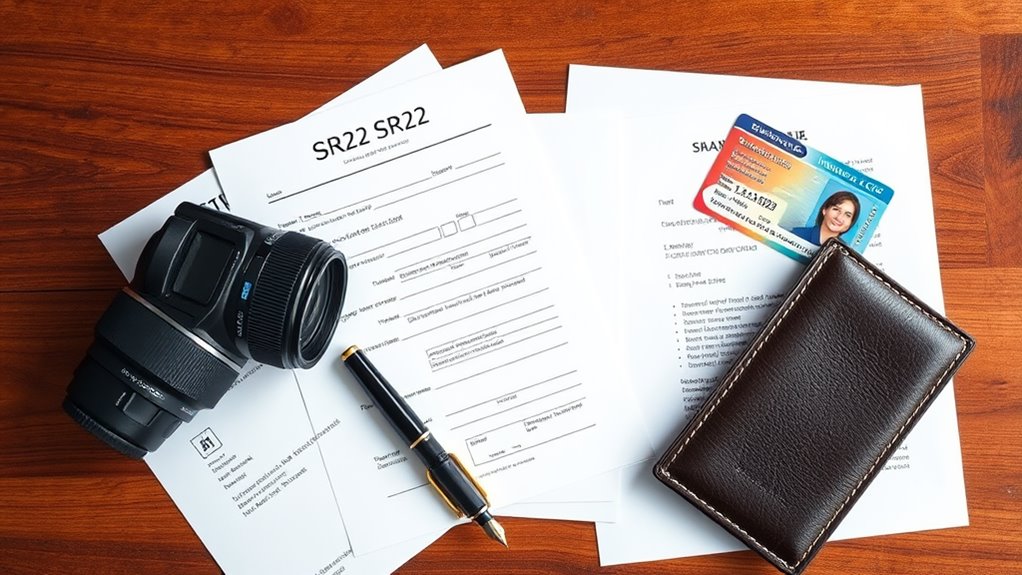2025-03-14
5 Tips for High-Risk Driver Bond Paperwork

Maneuvering high-risk driver bond paperwork can be intimidating, but understanding a few key elements can make a significant difference. You need to grasp your state's regulations regarding SR-22 and FR-44 filings. It's crucial to gather all required documentation before you proceed. An accurate SR-22 bond application is critical. But there's more to maintaining your financial responsibility and avoiding penalties. Let's explore the important steps you must take to guarantee compliance.
Key Takeaways
- Understand your state's specific regulations regarding SR-22 or FR-44 filings for high-risk drivers.
- Gather all necessary documentation, including your driver's license, VIN, and proof of financial responsibility.
- Complete the SR-22 bond application accurately to avoid delays and penalties.
- Maintain continuous insurance coverage to prevent lapses and additional financial penalties.
- Stay informed about filing deadlines and renewal processes to ensure compliance throughout the SR-22 duration.
Understand Your State's Regulations

When maneuvering the complexities of high-risk driver bond paperwork, it's vital to first grasp your state's specific regulations. Many states require you to obtain SR-22 insurance after serious violations like a DUI, which proves your financial responsibility to the DMV. Additionally, understanding the SR-22 insurance requirements can significantly impact your ability to drive legally.
The filing procedures typically see your insurance company submitting the SR-22 on your behalf. Be aware that the duration of the SR-22 requirement usually spans three years, though this can vary. Additionally, states like Florida and Virginia utilize FR-44s, demanding higher coverage limits. Understanding these nuances helps you navigate potential impacts, like increased insurance rates or policy non-renewal. Familiarizing yourself with these regulations is vital in maintaining compliance and securing your driving privileges. Moreover, since surety bonds require individuals to assume financial responsibility, knowing your options can be crucial if you're unable to obtain traditional coverage.
Gather Required Documentation
Gathering the required documentation is vital for maneuvering the high-risk driver bond process efficiently.
Collecting necessary documentation is essential for efficiently navigating the high-risk driver bond process.
Start by collecting your driver's license or state ID and verify your name and address match legal documents. You'll also need the Vehicle Identification Number (VIN) and proof of financial responsibility, such as statements showing your capability to cover bond premiums.
Additionally, gather details of previous driving incidents, including police reports or court documents. Financial documentation is important too; acquire credit reports, personal financial statements, and bank statements.
Don't forget proof of income, like payslips or tax returns. If applicable, prepare business financials.
This thorough documentation will greatly streamline your bond application process.
Complete the SR-22 Bond Application Accurately
Completing the SR-22 bond application accurately is essential, as even minor errors can lead to significant delays or penalties.
Follow these key steps to guarantee your application is correct:
- Guarantee all personal information, including your name and address, is accurate.
- Double-check your insurance details, verifying that coverage meets state minimums.
- Confirm that your insurance company is aware of the SR-22 filing requirements.
- File the SR-22 within the state's specified timeframe to avoid penalties.
- Be mindful of potential fees and increased premiums associated with the SR-22.
Monitor Your Financial Responsibility

To effectively manage your financial responsibility as a high-risk driver, it's crucial to stay vigilant about your insurance coverage and related obligations.
First, maintain continuous coverage to avoid lapses that could worsen your risk classification. An SR-22 is required in many states, often leading to higher premiums, so budget accordingly.
Your credit score may also affect your risk status, so monitor it closely and work on improving it. Be aware of the financial penalties for driving uninsured or violating regulations, as these can add to your financial burden.
Finally, plan long-term to manage your responsibilities, as the SR-22 requirement can last several years. Understanding these factors will help you navigate your financial obligations effectively.
Stay Informed About Filing and Renewal Processes
Managing your financial responsibility as a high-risk driver involves more than just maintaining coverage; it also requires staying updated on the filing and renewal processes for your SR-22. Here are key aspects to keep in mind:
- Understand SR-22 Requirements: Know what circumstances necessitate an SR-22.
- Filing Processes: Confirm your insurer submits the SR-22 to the DMV.
- Renewal Schedule: Be aware of your state's SR-22 duration, typically one to five years.
- Non-Owner Policies: If you don't own a vehicle, secure a non-owner SR-22 policy.
- Policy Termination: Recognize that while insurers can't cancel mid-term, they may adjust rates at renewal.
Staying informed can help you avoid penalties and guarantee compliance with state regulations.
Conclusion
Steering high-risk driver bond paperwork might feel like steering through a stormy sea, but with the right course, you can reach calmer waters. By understanding regulations and staying organized, you'll avoid unnecessary turbulence. Just like a sailor checks their compass before setting sail, you should regularly monitor your insurance and stay ahead of deadlines. Keep your paperwork in order, and you'll find that the path to compliance becomes clearer, letting you focus on safer driving.